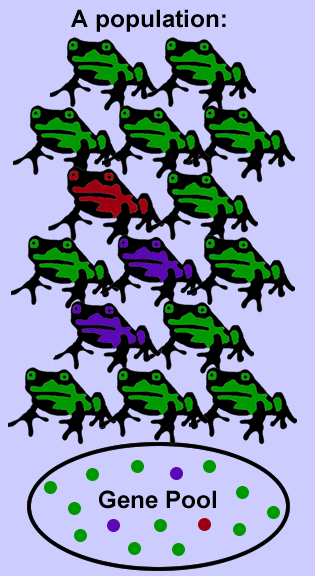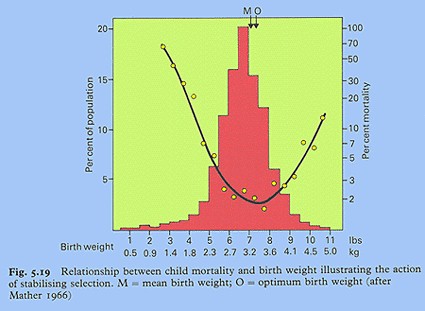
Evolution of Populations
A Introduction
2. The "Gene Pool"

"Courtesy of Windows to the Universe, http://www.windows.ucar.edu"
B. Genotype, phenotype and allele frequencies can be calculated
- genotype frequency:
example 1000 individuals
| Genotype | Number | Frequency |
| AA | 490 | |
| Aa | 420 | |
| aa | 90 | |
| Total | 1000 |
- phenotype frequency:
| Phenotype | Number | Frequency |
| Dominant | ||
| Recessive | ||
| Total |
- allele frequency:
| Allele | Number | Frequency |
| A | ||
| a |
Calculate genotype frequencies in the population using a Punnet Square:
0.7 A and 0.3 a (male population)
X
0.7 A and 0.3 a (female population)
- Hardy-Weinberg Equation:
p = frequency of dominant allele (A)
q = frequency of recessive allele (a)
p + q = 1
p2 + 2pq + q2 = 1
(AA) + (Aa) + (aa)
What is the frequencies of each of these genotypes when A = 0.7 and a = 0.3?
C. Hardy-Weinberg Equilibrium
Gene Frequencies of a population will not change if the following requirements are met:
Random mating, No net mutations, Large Population Size (no genetic drift), No migration (no gene flow), No natural selection
Evidence from research:
1. Non-random mating
-mating tends to occur with close neighbors (inbreeding)
-inbreeding does not change overall allele frequency in population, but can increase frequency of homozygous individuals and reduce fitness
2. Mutation (Read textbook to refresh your memory about this topic)
-What is a mutation?
somatic
sex cell
3. Genetic Drift
a. What is it?
In a population of 10,000 how many individuals would carry a rare allele with a q= 0.1?
What about in a population of 10?
4. Migration or Gene Flow
5. Natural Selection
a. Natural selection leads to adaptive change: it is not random
b. Genetic variation is the "raw material" for natural selection
-natural selection acts on the phenotype
structural
biochemical
behavioral
-expression of the phenotype is complex involving both the genotype and the environment:
single gene------single trait (Mendelian)
single gene------many traits (Pleiotropy)
many genes------one trait (polygenic)
-discrete characters: single gene locus with different alleles
-quantitative characters: polygenic with character distributed in a particular pattern (Normal distribution)
c. Sexual reproduction contributes to variation
d. Sex and natural selection
-sexual dimorphism leads to competition among males for females
-sex selection data in guppies
e. Genetic polymorphism is common in populations
-enzymes
f. Maintenance of genetic variation
-diploidy allows recessive alleles to be 'hidden' from selection
Evidence for natural selection is based on changes in distribution of phenotypes in the population
-stabilizing

from: http://www.micro.utexas.edu/courses/levin/bio304/popgen/nat.selection.html
-directional
cactus:
http://www.brooklyn.cuny.edu/bc/ahp/LAD/C21/C21_Directional.html
-disruptive
http://www.brooklyn.cuny.edu/bc/ahp/LAD/C21/C21_Disruptive.html